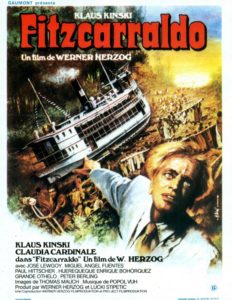Fitzcarraldo (1982)
5/5
Werner Herzog’s Fitzcarraldo (1982) is a film so bizarre that there are scenes that, in retrospect, I feel I must have dreamed. There is an untenable wild—a musty creeping of fortune and disaster—at the heart of this film. There’s an omnipresent sense of dread and unease that captures the viewer and slowly pulls them in like a sentient vine. And, although defining Fitzcarraldo is like pinning down a flapping trout with the back of a spoon, there are three aspects of the film that are undeniably integral to its most singular vision.
Set in the depths of the untamed Amazon rainforest, the events of Fitzcarraldo unfold in the jungle’s palm. There is never a moment when the wild of nature is not pressing in on all sides, suffocating. Herzog and crew shot on location, thousands of miles away from civilization, in areas only accessible by plane. The brilliant making-of documentary Burden of Dreams (1982) shows Herzog and the crew struggling to cope with the unforgiving nature of the jungle and suggests that only a crew who understood the hardship that the film’s characters undergo could accurately portray their undertaking.
Nowhere do we see the effects of the forest more than in the eyes of star Klaus Kinski, who plays Fitzcarraldo: a haunted, sunken, brooding that isn’t quite able to hide the trapped-animal fervour that burns inside them. Fitzcarraldo is similar to Apocalypse Now (1979) in the sense that both films’ protagonists are slowly destroyed from the inside out by the looming jungle. Kinski’s greatest strength is his ability to embody this destruction while also using it to his advantage, like riding a rockslide down a mountain. Without Kinski’s human embodiment of the Amazon’s wrath, Fitzcarraldo might have become an unintelligible mess.
The real hero, though, is Herzog himself—really, who else could make a film like this?—whose presence commands the film from start to finish. Certain directorial choices make Fitzcarraldo what it is. For example, letting the jungle’s sounds act as a soundtrack instead of drowning it out with an orchestrated score allowed the jungle’s omnipresence to be fully realized (although there is an unforgettable scene in which Fitzcarraldo attempts in vain to fight the forest with a gramophone and Bellini’s I Puritani). Even when sheltered by colonial mansions, or when on board a glorious steam ship, the jungle can be heard and sensed; it’s never forgotten.
That said, Fitzcarraldo never gives the jungle the satisfaction of victory, which is what keeps the film alive. Indeed, the brilliance of the film lies in the fact that Fitzcarraldo’s pristine and unwavering dedication to his ludicrous dreams (in this case, building an opera house in the Amazon) is never exceeded by the forest’s unwavering dedication to crush them. And it is in this that Fitzcarraldo becomes—remarkably—a defiantly human film. While it’s easy to lose sight of that fact, it’s just as easy to be inspired by it.

